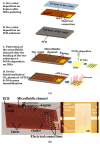Integrated Plastic Microfluidic Device for Heavy Metal Ion Detection
- PMID: 37630131
- PMCID: PMC10456536
- DOI: 10.3390/mi14081595
Integrated Plastic Microfluidic Device for Heavy Metal Ion Detection
Abstract
The presence of heavy metal ions in soil, air and water constitutes an important global environmental threat, as these ions accumulate throughout the food chain, contributing to the rise of chronic diseases, including, amongst others, cancer and kidney failure. To date, many efforts have been made for their detection, but there is still a need for the development of sensitive, low-cost, and portable devices able to conduct on-site detection of heavy metal ions. In this work, we combine microfluidic technology and electrochemical sensing in a plastic chip for the selective detection of heavy metal ions utilizing DNAzymes immobilized in between platinum nanoparticles (PtNPs), demonstrating a reliable portable solution for water pollution monitoring. For the realization of the microfluidic-based heavy metal ion detection device, a fast and easy-to-implement fabrication method based on the photolithography of dry photosensitive layers is proposed. As a proof of concept, we demonstrate the detection of Pb2+ ions using the prototype microfluidic device.
Keywords: DNAzyme; Kapton; Lab on a Chip; biosensor; heavy metal ion detection; microfabrication; microfluidics; nanoparticles.
Conflict of interest statement
The authors declare no conflict of interest.
Figures





Similar articles
-
Microfluidic Devices for Heavy Metal Ions Detection: A Review.Micromachines (Basel). 2023 Jul 28;14(8):1520. doi: 10.3390/mi14081520. Micromachines (Basel). 2023. PMID: 37630055 Free PMC article. Review.
-
Cost-effective microabsorbance detection based nanoparticle immobilized microfluidic system for potential investigation of diverse chemical contaminants present in drinking water.Anal Chim Acta. 2022 May 1;1205:339734. doi: 10.1016/j.aca.2022.339734. Epub 2022 Mar 18. Anal Chim Acta. 2022. PMID: 35414395
-
Non-Faradaic Impedimetric Detection of Heavy Metal Ions via a Hybrid Nanoparticle-DNAzyme Biosensor.Biosensors (Basel). 2024 Jun 27;14(7):321. doi: 10.3390/bios14070321. Biosensors (Basel). 2024. PMID: 39056597 Free PMC article.
-
Hybrid Nanoparticle/DNAzyme Electrochemical Biosensor for the Detection of Divalent Heavy Metal Ions and Cr3.Sensors (Basel). 2023 Sep 12;23(18):7818. doi: 10.3390/s23187818. Sensors (Basel). 2023. PMID: 37765875 Free PMC article.
-
Advances in Portable Heavy Metal Ion Sensors.Sensors (Basel). 2023 Apr 20;23(8):4125. doi: 10.3390/s23084125. Sensors (Basel). 2023. PMID: 37112466 Free PMC article. Review.
Cited by
-
Microfluidic Sensors Integrated with Smartphones for Applications in Forensics, Agriculture, and Environmental Monitoring.Micromachines (Basel). 2025 Jul 21;16(7):835. doi: 10.3390/mi16070835. Micromachines (Basel). 2025. PMID: 40731744 Free PMC article. Review.
-
Ensuring food safety: Microfluidic-based approaches for the detection of food contaminants.Anal Sci Adv. 2024 Apr 14;5(5-6):e2400003. doi: 10.1002/ansa.202400003. eCollection 2024 Jun. Anal Sci Adv. 2024. PMID: 38948318 Free PMC article. Review.
-
Development of a Portable Residual Chlorine Detection Device with a Combination of Microfluidic Chips and LS-BP Algorithm to Achieve Accurate Detection of Residual Chlorine in Water.Micromachines (Basel). 2024 Aug 18;15(8):1045. doi: 10.3390/mi15081045. Micromachines (Basel). 2024. PMID: 39203696 Free PMC article.
References
-
- Tsekenis G., Filippidou M.K., Chatzipetrou M., Tsouti V., Zergioti I., Chatzandroulis S. Heavy metal ion detection using a capacitive micromechanical biosensor array for environmental monitoring. Sens. Actuators B Chem. 2015;208:628–635. doi: 10.1016/j.snb.2014.10.093. - DOI
-
- Sharifi H., Tashkhourian J., Hemmateenejad B. Identification and determination of multiple heavy metal ions using a miniaturized paper-based optical device. Sens. Actuators B Chem. 2022;359:131551. doi: 10.1016/j.snb.2022.131551. - DOI
-
- Zhang J., Zhang Y., Wu J., Qi H., Zhao M., Yi M., Li Z., Zheng L. Real-time Cd2+ detection at sub-femtomolar level in various liquid media by an aptasensor integrated with microfluidic enrichment. Sens. Actuators B Chem. 2021;329:129282. doi: 10.1016/j.snb.2020.129282. - DOI
LinkOut - more resources
Full Text Sources
Research Materials
Miscellaneous

